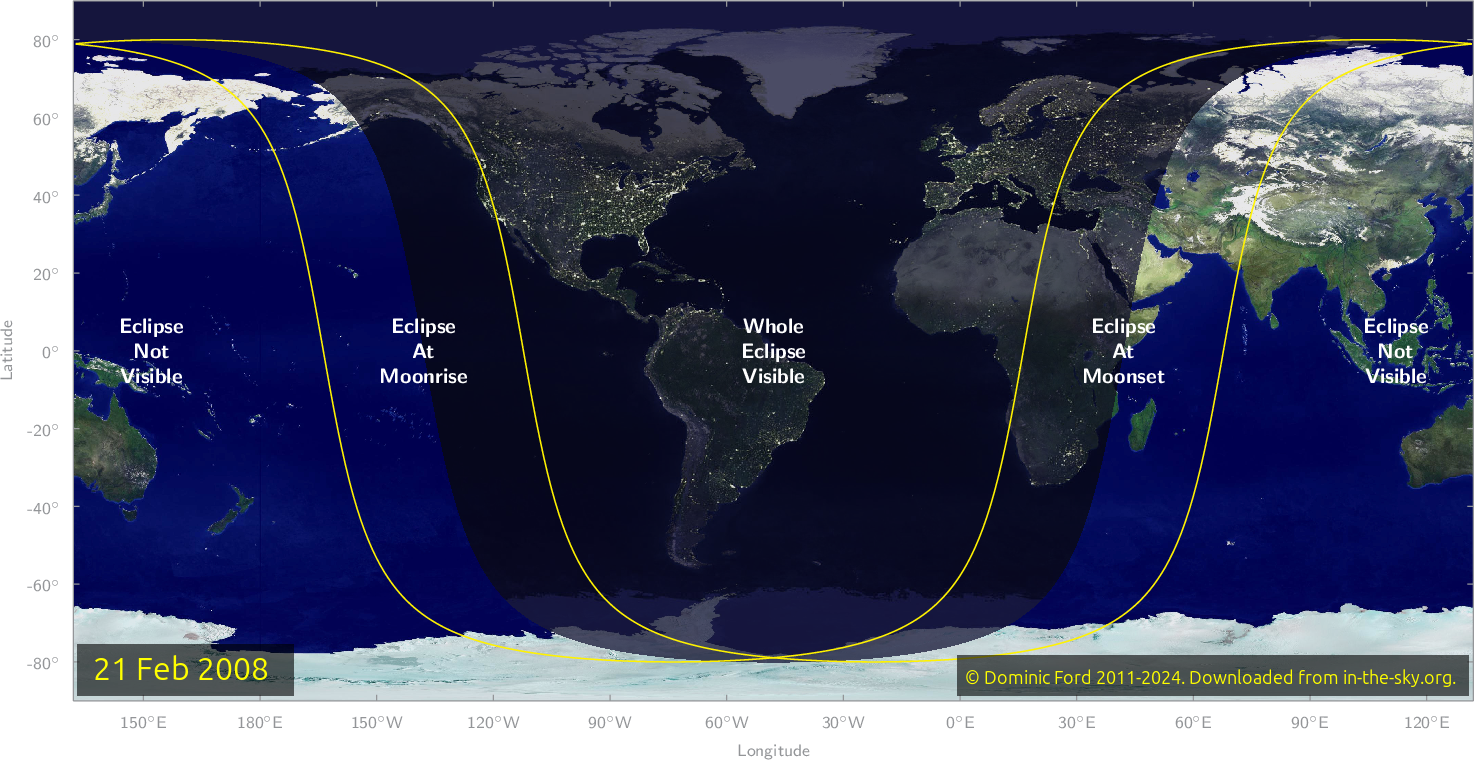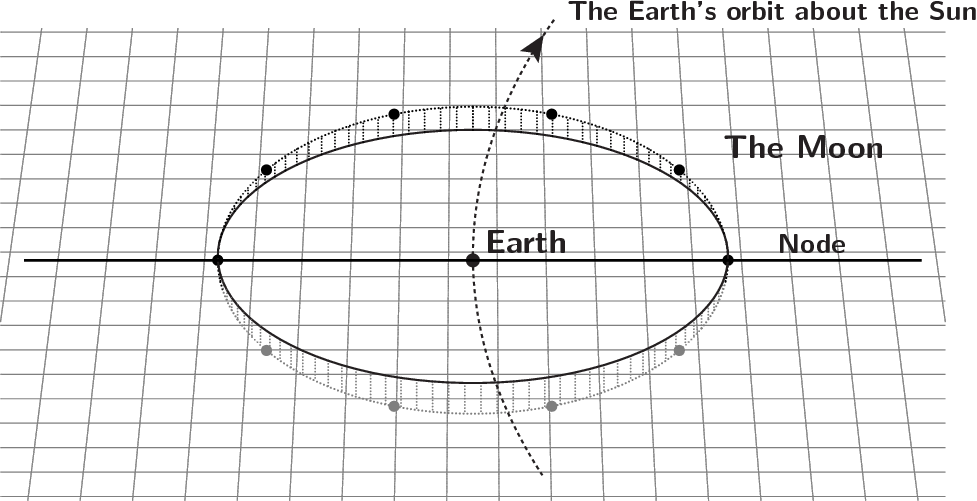The Moon will pass through the Earth's shadow between 16:37 and 22:16 PST, creating a total lunar eclipse. The eclipse will be visible any location where the Moon is above the horizon at the time, including from the Americas, Africa, Europe, south-western Russia, Antarctica, Asia and Alaska.
It will be visible from South El Monte in the eastern sky. The Moon will lie 22° above the horizon at the midpoint of the eclipse.
The total eclipse will last from 19:02 until 19:51. The Moon will be partially eclipsed between 17:44 and 21:09 (all times given in South El Monte time).
The simulation to the right shows Moon's path relative to the Earth's shadow. The outer grey circle is the Earth's penumbra, within which the Earth blocks part of the Sun's light, making the Moon appear less bright than usual, but not completely dark. The inner black circle is the umbra, within which the Earth entirely blocks the Sun's light, making the Moon's disk appear entirely unilluminated.
By default the eclipse is drawn with the local vertical in South El Monte uppermost (Zenith up), so that it is orientated as you would see it looking up at the Moon. The compass shows the direction of celestial north relative to the local vertical. Alternatively, you can orientate the sky with celestial north orientated uppermost, by selecting the option North up.
Selecting the option Diagram of Moon's path produces a static display of the Moon's path over the duration of the eclipse.
The lower panel shows the Moon's position in the sky relative to the horizon, as seen from South El Monte.
Timing
The eclipse will begin at 16:37, when the Moon first enters a region of the Earth's shadow called the penumbra. In this outer part of the Earth's shadow, an observer on the Moon would see the Earth partially obscuring the Sun's disk, but not completely covering it. As a result the Moon's brightness will begin to dim, as it is less strongly illuminated by the Sun, but it remains illuminated.
At 17:44, the edge of the Moon's disk will enter the Earth's umbra. This is the region of space in which an observer on the Moon's surface would see the Earth completely obscuring the whole of the Sun's disk, and would find themselves thrust into night-like darkness.
As an increasing fraction of the Moon's face creeps into the Earth's umbra, we see our planet's circular shadow sweep across the face of the Moon.
Eventually the Moon will pass entirely within the Earth's umbra at 19:02, and the total eclipse will begin.
The table below lists the times when each part of the eclipse will begin and end.
| Local time |
UTC | |
| 16:37 | 00:37 | Moon begins to enter the Earth's penumbra |
| 17:44 | 01:44 | Moon begins to enters the Earth's umbra. Partial eclipse begins. |
| 19:02 | 03:02 | Moon fully within Earth's umbra. Total eclipse begins. |
| 19:27 | 03:27 | Midpoint of eclipse |
| 19:51 | 03:51 | Moon begins to leave the Earth's umbra. Total eclipse ends. |
| 21:09 | 05:09 | Moon fully outside the Earth's umbra. Partial eclipse ends. |
| 22:16 | 06:16 | Moon leaves the Earth's penumbra |

Observing the eclipse
Eclipses of the Moon are easy to watch with the unaided eye. A modest pair of binoculars will give a superb view of the Moon's surface, but are not required. Unlike solar eclipses, lunar eclipses are entirely safe to look at without the need to look through any kind of filter.
They occur whenever the Earth passes between the Moon and Sun, such that it obscures the Sun's light and casts a shadow onto the Moon's surface.
When the Moon's disk lies entirely in shadow, it often takes on a spectacular reddy-brown color, as some of the Sun's red light is bent around the edge of the Earth's globe by its atmosphere.
Visibility of the eclipse
Eclipses of the Moon are visible anywhere where the Moon is above the horizon at the time. Since the geometry of lunar eclipses requires that the Moon is directly opposite the Sun in the sky, the Moon can be seen above the horizon anywhere where the Sun is beneath the horizon.
The map below shows where the eclipse of February 20 will be visible.

The eclipse geometry
Lunar eclipses occur when the Sun, Earth and Moon are aligned in a straight line, so that the Earth passes between the Sun and Moon and casts a shadow onto the latter's surface.
Each time the Moon orbits the Earth, it passes almost opposite to the Sun in the sky as it reaches Full Moon. If the Moon orbited the Earth in exactly the same plane that the Earth orbits the Sun, the Earth would pass between the Sun and Moon and create a lunar eclipse at Full Moon every month.

In fact, the Moon's orbit is tipped up at an angle of 5° relative to the Earth's orbit around the Sun. This means that the alignment of the Sun—Earth—Moon line at Full Moon usually isn't exact. As a result, an observer on the Moon would see the Earth pass a few degrees to the side of the Sun.
In the diagram to the right, the grid represents the plane of the Earth's orbit around the Sun. As it circles the Earth, the Moon passes through this Earth–Sun plane twice each month, at the points on the left and right labelled as nodes. A lunar eclipse happens only when one of these node crossings happens to coincide with Full Moon. This happens roughly once every six months, usually two weeks before or after a solar eclipse.
Further information
This eclipse is a member of Saros series 133. The position of the Moon at the midpoint of the eclipse is as follows:
| Object | Right Ascension | Declination | Constellation | Angular Size |
| The Moon | 10h14m | 10°29'N | Leo | 31'07" |
The coordinates above are given in J2000.0.
Next/previous eclipses
| « Previous | Next » | |||
| Visible from the Contiguous United States | Worldwide | Worldwide | Visible from the Contiguous United States | |
| 28 Aug 2007 | 28 Aug 2007 | Total Lunar Eclipses | 21 Dec 2010 | 21 Dec 2010 |
| 28 Aug 2007 | 28 Aug 2007 | Lunar Eclipses | 16 Aug 2008 | 09 Feb 2009 |
| 28 Aug 2007 | 07 Feb 2008 | Eclipses | 01 Aug 2008 | 09 Feb 2009 |
The sky on 19 Dec 2025
| The sky on 19 December 2025 | ||||||||||||||||||||||||||||||||||
|
0% 0 days old |
All times shown in PST.
|
|||||||||||||||||||||||||||||||||
Source
|
[1] – |
The lunar eclipse predictions presented on this website were computed using EphemerisCompute. This is an open-source tool which traces the positions of the Sun, Earth and Moon over the course of each eclipse and traces the path of the Moon through the Earth's shadow. It was written by the author and freely available for download from GitHub. It takes the positions of each body from the JPL DE430 planetary ephemeris. |
|
[2] – |
Espanak, F., & Meeus, J., Five Millennium Canon of Solar Eclipses: -1999 to +3000, NASA Technical Publication TP-2006-214141 (2006) |
|
[3] – |
The list of countries from which the eclipse is visible was computed on the basis of shape files available from DIVA-GIS. |
License
You may embed the map above in your own website. It is licensed under the Creative Commons Attribution 3.0 Unported license, which allows you to copy and/or modify it, so long as you credit In-The-Sky.org.
You can download it from:
https://in-the-sky.org/news/eclipses/lunar_20080221.png
Related news
| 13 Feb 2008 | – Moon at First Quarter |
| 20 Feb 2008 | – Full Moon |
| 28 Feb 2008 | – Moon at Last Quarter |
| 07 Mar 2008 | – New Moon |
Image credit
© John Buonomo, North Billerica, MA.
